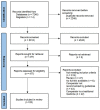Topical Traditional Chinese Medicines for Cancer Pain: A Systematic Review and Meta-analysis of Randomized Controlled Trials
- PMID: 37962002
- PMCID: PMC10647965
- DOI: 10.1177/15347354231210870
Topical Traditional Chinese Medicines for Cancer Pain: A Systematic Review and Meta-analysis of Randomized Controlled Trials
Abstract
Background and objectives: Safe and effective management of cancer-related pain is a worldwide challenge. In the search for treatment options, natural products used in Chinese herbal medicines (CHMs) have received attention in clinical studies for their effects on cancer-related pain. The objective of this systematic review is to evaluate the clinical evidence for topically applied CHMs as adjunctive treatments for cancer pain management.
Methods: Nine biomedical databases and 4 clinical trial registries were searched for randomized-controlled trials (RCTs) that reported measures of pain and/or quality of life. Risk of bias was assessed using the Cochrane tool. Meta-analysis employed mean difference (MD) with 95% confidence intervals (random effects).
Results: Twenty (20) RCTs (1636 participants) met the inclusion criteria. Meta-analyses were grouped based on the comparisons and outcome measures. For pain intensity, there was a greater reduction in the topical CHM group versus placebo (MD -0.72 [-1.04, -0.40]), no difference when compared to tramadol (MD -0.15 [-0.38, 0.08]), and a greater reduction when topical CHMs were combined with conventional analgesic medications (MD -0.67 [-0.93, -0.40]). Analgesic onset time was reduced in the CHM group compared to tramadol (MD -26.02 [-27.57, -24.47] minutes), and for CHMs combined with conventional medications (MD -19.17 [-21.83, -16.52] minutes). When CHMs were combined with analgesic medications, improvements were found for duration of analgesia (MD 1.65 [0.78, 2.51] hours), analgesic maintenance dose (MD -31.72 [-50.43, -13.01] milligrams/day), and quality of life.
Conclusion: Addition of topical CHMs to conventional analgesic medications was associated with improved outcomes for pain intensity, some other pain-related outcomes, and measures of quality of life. Limitations included methodological issues in some studies and considerable heterogeneity in some pooled results.
Keywords: Chinese medicine; cancer pain; herbal medicine; meta-analysis; natural products; topical analgesic; traditional medicine.
Conflict of interest statement
Declaration of Conflicting InterestsThe author(s) declared no potential conflicts of interest with respect to the research, authorship, and/or publication of this article.
Figures
References
Publication types
MeSH terms
Substances
LinkOut - more resources
Full Text Sources
Medical
Miscellaneous



